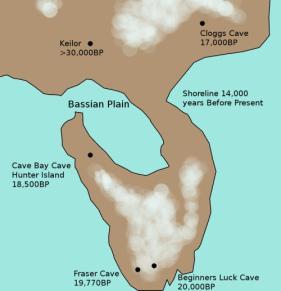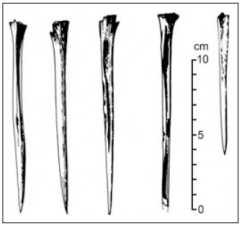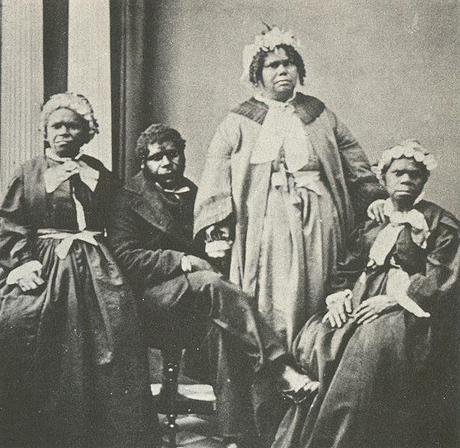
Tasmania 14,000 years ago; when it was still connected to the Mainland. The dots are sites we know people lived in from this period
Around 30,000 years ago a group of Australians migrated into an isthmus on the south coast of Australia1. As the last glacial period came to an end ice sheets around the world melted and sea levels rose almost 100 meters2. By ~12,000 years ago this isthmus had become an island, its inhabitants cut off from the rest of the world. These early islanders produced complex technology; on par with anything found on the mainland. They could make weapons, bone tools, composite technology, cold weather clothing and they were excellent at fishing. Archaeological evidence from this period indicates fish made up almost 1/5 of their diet1.
In the 18th century European ships begin to stop at the island; which eventually came to be called Tasmania. The seas around Tasmania were full of fish and were a great place to replenish food reserves after a long voyage. This fact surprised the original inhabitants of the island. Upon seeing these Europeans eat the fish they were disgusted and point blank refused all offers by the sailors to share in the bounty. It would seem that in the intervening 12,000 years the aboriginal Tasmanians had forgotten how to fish and become revolted at the very idea of eating it (and even if they sometimes accidentally caught them whilst gathering shellfish they would not eat them)1.
And that wasn’t the only thing. Their cold weather clothing, bone tools, barbed spears, spear throwers, boomerangs and stone tipped spears and much more had all vanished from the Tasmanian repertoire; despite the fact their cousins on the Australian mainland were still making them. Some early observers even thought they had forgotten how to make fire, instead preferring to maintain existing fires (although this was later found to be false. They could still make fire, they just preferred to curate it)1.

Simple bone points, used to make clothes, stopped being manufactured by Tasmanians even though people on the mainland continued to create them
Looking at the archaeological record things get even more fascinating. 8,000 years ago fish made up 21% of the Tasmanian diet, making them the second most valued food source (after seals) and three times greater than wallabies. Yet by 3,800 years ago they had completely disappeared from the record; replaced by wallabies, shellfish and seals. Bone tools follow a similar trajectory. 7,000 years ago they were being made 1/3 as often as stone tools. 4,000 years ago it was 1/15 as often and by 3,000 years ago they vanished entirely. In other words, although they’d been living on Tasmania for over 30,000 years, it was only after it became an island and they were cut off from the rest of Australia that their technology began to degenerate1.
Perhaps what’s most interesting isn’t that all of this technology disappeared; but that in the intervening 4,000 years it never re-appeared. That’s 4,000 years of people accidentally catching fish whilst gathering fish and at no point did anyone think “hmm, I wonder if I could eat it.” Instead these techniques remained gone from the record, and in the case of fish they even developed an active dislike for it1.
So what on earth happened?
There are dozens of possible explanations for this turn of events. Some doubt that they even had these technologies in the first place. The fish bones are just from the stomachs of the seals they always hunted; mainland Australians developed warm clothes after the split so the Tasmanians never had them to lose. So why did fish cease to appear in the archaeological record when they kept hunting seals? And why were they making the bone points used to create cold weather clothes if they never invented them? In most cases there is strong evidence that the Tasmanians once had this ability, but lost it1.
Another idea is that these complex tools just weren’t need to survive in Tasmania. It’s a pleasant place (well, as pleasant as anywhere in the deathtrap that is Australia can be) and one could survive just as well with a sharpened wood spear as they could with a stone-tipped one. So why bother making stone tipped ones? Some of the bone tools used to make cold weather clothes disappear as the temperature begins to rise. Could it be all these tools were simply unnecessary? This could explain some of the disappearances, but not all of them3. Again, they sometimes accidentally catch fish but don’t eat them. They’re doing a lot of the steps needed to fish, but aren’t actually fishing. This alternative doesn’t seem much easier than just getting some damn fish in the first place1.

The last four full-blooded native Tasmanians. Taken in the 1860s
Which brings us to the most controversial idea: demography. Cut off from the mainland the Tasmanian population was stuck at around 4,000 individuals3. This simply wasn’t enough people to sustain these technologies. With a smaller population there is less chance you’ll get people good at making these tools, forcing you to learn from more average teachers. But the learning process is imprefect, so your tools will be sub-par; and when the next generation learns from you it will be lower still. Over time they’ll disappear entirely and only the easy to make technologies will remain1.
But this all rests on the idea that learning from someone necessarily produces an inferior result; and that’s what a lot of the debate is about. Many argue that it is simply untrue and there are numerous studies showing that learning from someone can result in tools just as good as theirs’3,4. Besides, if this was the case why are the groups with a smaller population that still have complex technology? Some of the early inhabitants of Greenland became isolated and numbered just 600 individuals; yet their technology did not degenerate3.
However, it is becoming apparent that whilst small populations don’t halt teaching they do decrease the chance of innovation. In a smaller group there is less chance some technological genius will arise; capable of inventing new tools. As such, if some technology was lost on Tasmania for another reason (like life being easy, or it not being present in the first place) it would be unlikely to re-appear4.
This has some fascinating implications for human evolution. Around 150,000 years ago our ancestors were making tools just as advanced as any other species of human (like the Neanderthals). But over the next 100,000 years or so our technology took off and we invented dozens of new tools, hunting techniques and more. Armed with this new technology we colonised the whole planet and out-competed all the other species of human living alongside us (like the Neanderthals)5. For years people have debated what it was that kicked off this “revolution.” Perhaps there was a brain mutation that made our ancestors smarter? Maybe their environment drove them to be more innovative? Maybe their brain was just differently organised from all the other humans?
But this Tasmanian example suggests the explanation was much more mundane. Perhaps the secret to our success isn’t that we’re super smart or special; there’s just a lot of us, increasing the chance an innovator is born. Human success is based around the fact we multiply.
A lot.
References
- Henrich, J. (2004). Demography and cultural evolution: How adaptive cultural processes can produce maladaptive losses-The Tasmanian case. American Antiquity, 69(2), 197-214.
- Lambeck, K., & Chappell, J. (2001). Sea level change through the last glacial cycle. Science, 292(5517), 679-686.
- Read, D. W. (2011). The misuse of a mathematical model: the Tasmanian case (reply to Henrich’s response).
- Baldini, R. (2013). Revisiting the effect of population size on cumulative cultural evolution. bioRxiv
- d’Errico, F., & Stringer, C. B. 2011. Evolution, revolution or saltation scenario for the emergence of modern cultures? Philosophical Transactions of the Royal Society B: Biological Sciences, 366(1567):1060-1069.

